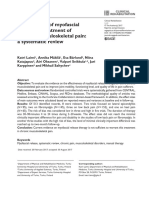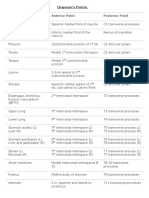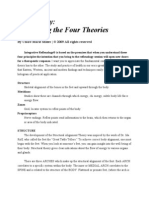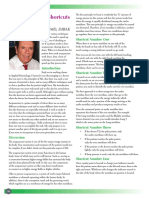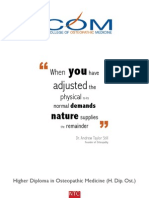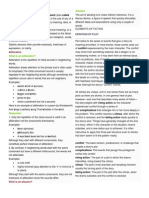Primitive Reflexes: (Birth To 2-4 Months)
Primitive Reflexes: (Birth To 2-4 Months)
Uploaded by
Mic De Castro NaguitCopyright:
Available Formats
Primitive Reflexes: (Birth To 2-4 Months)
Primitive Reflexes: (Birth To 2-4 Months)
Uploaded by
Mic De Castro NaguitOriginal Description:
Original Title
Copyright
Available Formats
Share this document
Did you find this document useful?
Is this content inappropriate?
Copyright:
Available Formats
Primitive Reflexes: (Birth To 2-4 Months)
Primitive Reflexes: (Birth To 2-4 Months)
Uploaded by
Mic De Castro NaguitCopyright:
Available Formats
PRIMITIVE REFLEXES
AGE OF
REFLEX STIMULUS RESPONSE CLINICAL SIGNIFICANCE
SUPPRESSION
Baby will begin to suck Premature babies may have a weak
Sucking Roof of the baby’s mouth is 3 months
or immature sucking ability
touched
Crawl Reflex Pulling their legs under their
Place baby on their stomach body and kick them out in 3-4 months
crawling motion
Rooting Diminished in CNS pathology, may
Stroking lips/around mouth Moving mouth or head 4 months
present in CNS pathology.
forward stimulus in search
(Birth to 2-4 months) May ensure successful breastfeeding
of nipple
Symmetrically fling the arms
Moro Sudden neck extension 4-6 months Persists in CNS pathology static
(Shoulder abd, elbow &
encephalopathy
finger extension) Reverse
Startle Sudden noise flexion
(Arm flexion and adduction)
Obligatory or hyperactive abnormal
3-5 months replaced
Positive Light pressure or WB on Legs extend for partial at any age, early sign of lower
by volitional weight
Supporting plantar surface support of body weight extremity spasticity, may be
bearing with support
associated with scissoring
Asymmetric Tonic Extremities extend on face
Head turning to side 6-7 months
Neck side, flex on occiput side Obligatory response abnormal at
(5-6 months)
any age, persists in static
Symmetric Tonic Neck flexion Arms flex, legs extended
6-7 months encephalopathy
Neck Neck extension Arms extend, legs flex
Touch or pressure on palm or Flexion of all fingers/ Grasp
Palmar Grasp 5-6 months Diminished in CNS suppression,
stretching finger flexors Removal of Stimuli: tighter
absent in LMN paralysis; persists
grip (3-4 months)
hyper-active in spasticity
Pressure on sole distal to MT 12-14 months when
Plantar Grasp Flexion of all toes
heads walking is achieved
On vertical support plantar
Automatic Alternating automatic Variable activity in normal
contact and passive tilting of 3-4 months
Neonatal Waking/ steps with support infants, absent in LMN
body forward and side-to-
Step/ Dance paralysis
side
Tactile contact on dorsum of Extremity flexion to place Absent in LMN paralysis or with LE
Placement or Before end of first year
foot or hand hand spasticity
Placing
or foot over an obstacle
Sequential body rotation
Neck Righting or 4 months replaced Nonsequential leg rolling
Neck rotation in supine from shoulder to pelvis
Body Denotational by volitional rolling suggests increased tone
towards
direction of face
Supine Predominant extensor tone Hyperactivity/obligatory abnormal
Tonic Labyrinthine 4-6 months at any age persists in CNS
Prone Predominant flexor tone (2-4 months) damage static encephalopathy
PHYSIOLOGIC POSTURAL REFLEX RESPONSES
AGE OF
REFLEX STIMULUS RESPONSE CLINICAL SIGNIFICANCE
EMERGENCE
Align face/head vertical, Prone – 2 months
Head Righting Visual and vestibular
mouth horizontal Supine – 3-4 months
Align body parts in
Head and Tactile,
anatomic position relative to 4-6 months
Body Vestibular,
each other and gravity
Righting Proprioceptive
Protective Displacement of center of Extension/abduction of Anterior 5-7 Delays or absent in
Extension or gravity outside supporting lateral extremity toward Lateral 6-8 CNS Immaturity or
Parachute base in sitting, standing displacement to prevent Posterior 7-8 damage
Reactions falling Standing 12 - 14
Adjustment of tone and Sitting – 6-8
Displacement of center
Equilibrium or posture of trunk to maintain months Standing
of gravity
Tilting balance – 12-14
months
Primitive/ Spatial Tonic/ Brainstem Midbrain/ Cortical
Flexor Withdrawal Positive Support Equilibrium
Crossed Extension ATNR NOB
Traction STNR BOB
Moro TLR BOH
Startle Associated Reaction Optic Righting with Vision
Palmar Grasp Optic Righting without Vision
Plantar Grasp Protective Extension
Classification of
Afferent Nerve Center Efferent Nerve Response
Reflex Reflex
Corneal Polysynaptic Contraction of the orbicularis oculi
Ophthalmic Branch of
Right Superficial Pons CN VII (blinking of both eyes)
CN V
Left Visceral
Pupillary Direct: constriction of stimulated
Polysynaptic Edinger Westphal
Right eye ipsilateral/stimulated eye
Superficial CN II nucleus at CN III
Left eye Consensual: Constriction of contralateral
Visceral Midbrain
eye
Gag or Polysynaptic Gagging: vomiting as response; Soft
Vomiting Superficial CN IX Spinal Cord CN X palate elevation
Visceral
Jaw Jerk Monosynaptic Mandibular branch (v3) of Contraction of temporal muscles
Pons CN V
Deep Trigeminal Nerve (CN V)
Biceps Jerk Monosynaptic Flexion of elbow
C5-6 Spinal cord CV - VI
Deep
Triceps Jerk Monosynaptic Extension of elbow
C7-8 Spinal cord CN VII - VIII
Deep
Abdominal Polysynaptic Upper: T8-10 Upper: T8-10 Contraction of ipsilateral abdominal
Spinal cord
Superficial Lower: T10-12 Lower: T10-12 muscles on the stroked side
Knee Jerk Monosynaptic Knee extension
L2-4 Spinal cord L2-4
Deep
Ankle Jerk Monosynaptic Plantarflexion
S1-2 Spinal cord S1-2
Deep
Plantar Polysynaptic N: Toe curling or no reaction
S1-2 Spinal cord S1-2
Superficial (+)/Abn: Extension of big toe or fanning
You might also like
- VISA INVITATION LetterDocument1 pageVISA INVITATION Letteristiuktushar2No ratings yet
- Case: Molson Coors and AcquisitionsDocument5 pagesCase: Molson Coors and AcquisitionsJas100% (1)
- Case Report Example and AbstractDocument8 pagesCase Report Example and AbstractMyra Lyn OloresNo ratings yet
- The Fasciacytes, A New Cell Devoted To Fascial Gliding Regulation - Stecco 2018Document30 pagesThe Fasciacytes, A New Cell Devoted To Fascial Gliding Regulation - Stecco 2018Nahuel SteinmannNo ratings yet
- Raphael Rettner - End PMS NowDocument58 pagesRaphael Rettner - End PMS NowYuldash100% (1)
- AK - Shortcuts - 2 - Manual - Online - CourseDocument62 pagesAK - Shortcuts - 2 - Manual - Online - Courseandrey.brenerNo ratings yet
- 2006 CompleteDocument80 pages2006 CompleteRukaphuongNo ratings yet
- Introduction To Muscle Testing The Gaits and Repeated Muscle TestsDocument37 pagesIntroduction To Muscle Testing The Gaits and Repeated Muscle TestsDr. Robert FrostNo ratings yet
- Electives SyllabusDocument63 pagesElectives SyllabusRahulKumarNo ratings yet
- Muscle Test Summary - 230613 - 232607Document14 pagesMuscle Test Summary - 230613 - 232607عثمان عابدينNo ratings yet
- CCWS Candida Cell Wall Suppressor Treatment Protocol / Instructions For UseDocument4 pagesCCWS Candida Cell Wall Suppressor Treatment Protocol / Instructions For UseCCWS Candida Cleanser Treatment Protocol100% (1)
- ConstipationDocument22 pagesConstipationash ash100% (1)
- Raphael Rettner - Releasing Birth TraumaDocument46 pagesRaphael Rettner - Releasing Birth TraumaYuldash100% (3)
- A Brief History of KinesiologyDocument5 pagesA Brief History of Kinesiologygroschen- romanNo ratings yet
- Aama Myofascial Meridians ArticleDocument8 pagesAama Myofascial Meridians Articledoktormin106No ratings yet
- Autonomic Regulation 1Document5 pagesAutonomic Regulation 1Darren StarwynnNo ratings yet
- Anatomic Connections of The Diaphragm Influence of Respiration On The Body SystemDocument11 pagesAnatomic Connections of The Diaphragm Influence of Respiration On The Body SystemMarcus Dos Santos100% (1)
- Glandular Type DietDocument4 pagesGlandular Type DietRosa María Rodríguez de PaoliNo ratings yet
- Asian Herbal Soups One-Pot Meals by Tan, TerryDocument150 pagesAsian Herbal Soups One-Pot Meals by Tan, TerryLaboratorium LawangNo ratings yet
- JSJ Self Help Guide PDFDocument27 pagesJSJ Self Help Guide PDFhernan letelier marinNo ratings yet
- Immune CureDocument6 pagesImmune CurezotzedNo ratings yet
- Stress Release Issue LayoutDocument30 pagesStress Release Issue LayoutmoiNo ratings yet
- Viscero-Somatic Reflex Anterior Point Posterior Point: Chapman's PointsDocument3 pagesViscero-Somatic Reflex Anterior Point Posterior Point: Chapman's PointsEman ElzeftawyNo ratings yet
- Body Talk: Assignment-6Document7 pagesBody Talk: Assignment-6Sankar AmiNo ratings yet
- Physical Therapy For Neurological Disorders (2) 2Document11 pagesPhysical Therapy For Neurological Disorders (2) 2Muskan AhujaNo ratings yet
- Liver - Gallbladder: Light Fluid Blue: 1 Minute Balancing GelDocument22 pagesLiver - Gallbladder: Light Fluid Blue: 1 Minute Balancing GeldiNo ratings yet
- Histamine Intolerance Food List V2FINALDocument15 pagesHistamine Intolerance Food List V2FINALJalia MirNo ratings yet
- Miller Integrative ReflexologyDocument6 pagesMiller Integrative Reflexologymax00haNo ratings yet
- The Different Types of InsomniaDocument5 pagesThe Different Types of InsomniaChirayu SharmaNo ratings yet
- Therapyprotocols: Dynamic Muscular Stabilization TrainingDocument9 pagesTherapyprotocols: Dynamic Muscular Stabilization TrainingGraciete PsaromilingosNo ratings yet
- Four Step Square Test InstructionsDocument4 pagesFour Step Square Test InstructionsMichael Giava Brovanna BrandoliNo ratings yet
- Corporate Chair Massage Brochure IIDocument1 pageCorporate Chair Massage Brochure IIastroNo ratings yet
- Acupuncture Shortcuts For Kinesiologists PDFDocument2 pagesAcupuncture Shortcuts For Kinesiologists PDFCFYO Manuel Salgado FernándezNo ratings yet
- Review Session 3 - Bones Muscles of Upper Limb and TrunkDocument30 pagesReview Session 3 - Bones Muscles of Upper Limb and Trunkapi-547400638No ratings yet
- Brain Gym Aspectos Del AprendizajeDocument25 pagesBrain Gym Aspectos Del AprendizajeJhonny Hernandez OsorioNo ratings yet
- WWW - Chiropractic SportsDocument5 pagesWWW - Chiropractic Sportsapi-3714923No ratings yet
- Raphael Rettner - 5 Ways To Lose 10 Lbs. in 30 DaysDocument29 pagesRaphael Rettner - 5 Ways To Lose 10 Lbs. in 30 DaysYuldash100% (1)
- 2006 ThieDocument5 pages2006 ThieBảo NhấtNo ratings yet
- Osteopathy ProspectusDocument20 pagesOsteopathy Prospectussdun7No ratings yet
- Lower-Nerve FlossingDocument1 pageLower-Nerve Flossingdobrica ilicNo ratings yet
- Cupping Info: Before & After-Care: Prior To Your Cupping SessionDocument3 pagesCupping Info: Before & After-Care: Prior To Your Cupping SessionMichael Lopez100% (2)
- Thru S-S Pivot - Jugular ProcessesDocument5 pagesThru S-S Pivot - Jugular ProcessesveronicaNo ratings yet
- 4) Lumbar Spinous Push Technique (Type IV), Iliomamillary PushDocument3 pages4) Lumbar Spinous Push Technique (Type IV), Iliomamillary PushNoorAkNo ratings yet
- Terra Rosa E-Magazine No. 12Document33 pagesTerra Rosa E-Magazine No. 12Terra RosaNo ratings yet
- Right Ear:: Within A Radius of 2 CM (.8 In) Green: 1 MinuteDocument26 pagesRight Ear:: Within A Radius of 2 CM (.8 In) Green: 1 MinutediNo ratings yet
- Energetic Kinesiology21Document1 pageEnergetic Kinesiology21Marius Dan GiolgauNo ratings yet
- Compilation Conditions + FormulasDocument2 pagesCompilation Conditions + Formulaspeter911x0% (1)
- Touch For Health Casework02-Amy Choi Eng 2019Document15 pagesTouch For Health Casework02-Amy Choi Eng 2019RukaphuongNo ratings yet
- OPP Course Review: John Garlitz, DO Deborah Schmidt, DO Opp 2 April 15, 2015 8:10 AMDocument248 pagesOPP Course Review: John Garlitz, DO Deborah Schmidt, DO Opp 2 April 15, 2015 8:10 AMmina botross100% (1)
- The Role of Cupping Therapy in Pain Management A LDocument19 pagesThe Role of Cupping Therapy in Pain Management A LMohitha Parla100% (1)
- Babies, Children and Families: The Promise of RolfingDocument31 pagesBabies, Children and Families: The Promise of RolfingRui Pedro PereiraNo ratings yet
- Course: Inner Peace Center StageDocument14 pagesCourse: Inner Peace Center StagepluigiaNo ratings yet
- (Handbook of Sensory Physiology 1) Werner R. Loewenstein (Ed.) - Principles of Receptor Physiology-Springer (1971)Document629 pages(Handbook of Sensory Physiology 1) Werner R. Loewenstein (Ed.) - Principles of Receptor Physiology-Springer (1971)SIDNo ratings yet
- 01 - Chapter - Sympathetic Nervous System and PainDocument32 pages01 - Chapter - Sympathetic Nervous System and Painbcvaughn019No ratings yet
- Inflammation and Infection Part II: Pulse DX & Herbal TX: by Jimmy Chang, L.Ac., O.M.DDocument3 pagesInflammation and Infection Part II: Pulse DX & Herbal TX: by Jimmy Chang, L.Ac., O.M.DShahul HameedNo ratings yet
- Simple Energy Techniques ReportDocument7 pagesSimple Energy Techniques ReportAnthony M. Davis100% (1)
- OPTIMAL EftDocument3 pagesOPTIMAL Eftemofree100% (1)
- Brainchange: Grea T D Oor ChinaDocument4 pagesBrainchange: Grea T D Oor ChinaJack Carney100% (1)
- ReflexologyDocument3 pagesReflexologyGowthamrajNo ratings yet
- EmbryologyDocument5 pagesEmbryologyMic De Castro NaguitNo ratings yet
- Responsible Parenthood and Reproductive Health Act of 2012Document7 pagesResponsible Parenthood and Reproductive Health Act of 2012Mic De Castro NaguitNo ratings yet
- What Are Stylistic DevicesDocument17 pagesWhat Are Stylistic DevicesMic De Castro NaguitNo ratings yet
- Monica Lucille C. Naguit: IV-GentlenessDocument3 pagesMonica Lucille C. Naguit: IV-GentlenessMic De Castro NaguitNo ratings yet
- Full Download Test Bank For Science of Nutrition 3rd Edition Thompson PDF Full ChapterDocument36 pagesFull Download Test Bank For Science of Nutrition 3rd Edition Thompson PDF Full Chapterkilter.murk0nj3mx100% (25)
- QF 450 10 Rev. B Specification Log SheetDocument11 pagesQF 450 10 Rev. B Specification Log Sheetjianli wangNo ratings yet
- Concept of Leadership and ManagementDocument59 pagesConcept of Leadership and ManagementDaniela OrtalNo ratings yet
- Evaluation of PH of Bathing Soaps and Shampoos For Skin and Hair CareDocument7 pagesEvaluation of PH of Bathing Soaps and Shampoos For Skin and Hair CareHanifah MukhsinNo ratings yet
- Quiz CHNDocument3 pagesQuiz CHNShane SappayaniNo ratings yet
- Suicide Term Papers FreeDocument8 pagesSuicide Term Papers Freeafdttjcns100% (1)
- Candidate: Task 1 MonologueDocument4 pagesCandidate: Task 1 MonologueAna VicianoNo ratings yet
- Handling Returned Products Forf CostumerDocument5 pagesHandling Returned Products Forf CostumerCyril Balla100% (1)
- Blood DyscrasiaDocument4 pagesBlood DyscrasiaEm Hernandez Arana100% (1)
- Diagnosis of PregnancyDocument53 pagesDiagnosis of PregnancyAdrija MukherjeeNo ratings yet
- Individual Development Plan For Professional DevelopmentDocument2 pagesIndividual Development Plan For Professional DevelopmentJerson S. SantiagoNo ratings yet
- JHS OnlineDocument109 pagesJHS OnlineJovil John OsuneroNo ratings yet
- Prospectus: (CBSE AFFILIATION NO. 1930798)Document20 pagesProspectus: (CBSE AFFILIATION NO. 1930798)zymcaryNo ratings yet
- RehabilitationDocument14 pagesRehabilitationSumi SajiNo ratings yet
- Choose Two Correct Answers Out of The Five Options Given:: A. B. C. D. eDocument3 pagesChoose Two Correct Answers Out of The Five Options Given:: A. B. C. D. emr mahmoudNo ratings yet
- 10 Reasons Why Abortion Is WrongDocument2 pages10 Reasons Why Abortion Is Wrongscotsman33No ratings yet
- Levine Sign - Google SearchDocument1 pageLevine Sign - Google SearchMathan KarthikNo ratings yet
- Simple LP ProblemsDocument19 pagesSimple LP ProblemsJithu R KrishnanNo ratings yet
- 60 Transporting PointsDocument23 pages60 Transporting Pointsabuswalih5353No ratings yet
- Queries From Bar Takers - 18aug23Document8 pagesQueries From Bar Takers - 18aug23Angelica FielNo ratings yet
- Skin Disease in DogsDocument18 pagesSkin Disease in DogsBibek SutradharNo ratings yet
- Classroom Management and InteractionDocument12 pagesClassroom Management and InteractionSalsha NabilaNo ratings yet
- Morgandermody cv051223 IptecDocument10 pagesMorgandermody cv051223 Iptecapi-668510785No ratings yet
- Nellcor - Pulse Oximeter - Pm100n SpecsDocument2 pagesNellcor - Pulse Oximeter - Pm100n Specsmahesh senanaykeNo ratings yet
- Blue Gold Watercolour Group Project Presentation 20231201 212051 0000.Pptx 20231201 215238 0000Document12 pagesBlue Gold Watercolour Group Project Presentation 20231201 212051 0000.Pptx 20231201 215238 0000NIRAV TAWADIANo ratings yet
- NSI Form - 25 - 10 - 2021Document2 pagesNSI Form - 25 - 10 - 2021sizeninhleko8No ratings yet
- Merit-Placement - List-hec-FATADocument2 pagesMerit-Placement - List-hec-FATAHamayon Wazir50% (2)
- نموذج بك صيدله سريريه صنعاء 2022 12 29Document11 pagesنموذج بك صيدله سريريه صنعاء 2022 12 29MohammedNo ratings yet

















